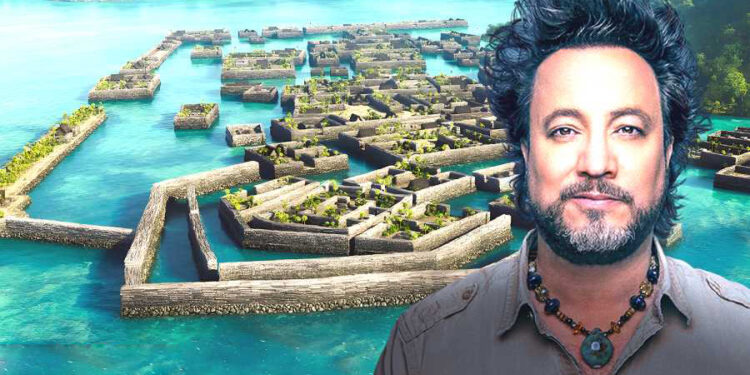Nan Madol, which is located near the southern side of the Federated States of Micronesia, is the only ancient city ever built atop a coral reef. In 2016, UNESCO declared it a World Heritage Site. The mighty ruins of this enigmatic place, which is a little smaller than New York City, set apart between the main island of Pohnpei and Temwen Island. The ruins of Nan Madol go back to the remote past, but its prehistoric layout has not been dated and the origin of its builders is unknown.
Constructed in a lagoon and surrounded by water on three sides with a stone wall enclosing the complex, the city is often referred to as the “Venice of the Pacific.” Built from 250 million tons of volcanic rock, could the local legends be true that strange visitors floated the massive rocks through the air? The weight of the huge rocks varies between 5 to 40 tons.
When the first European explorers arrived in the city in the 1800s, they were surprised to the point that they considered the mighty ruins the eighth wonder of the world. The megalithic buildings are still standing, even though their foundations are underwater.
Unfortunately, the ruins do not have any artistic elements or petroglyphs to help determine when it was built. Nor can it be established which civilization inhabited it. On this point, there are several discrepancies among experts. Differences that made Nan Madol an unsolved mystery.
For the mainstream researchers, Nan Madol was built in the 2nd century AD. But it is possible that this date only corresponds to the oldest human remains found on the island, and not to the construction. There is evidence to support this theory. A striking fact is that the foundations of Nan Madol are submerged.
How could they start construction with such large and heavy rocks underwater at that time? This detail suggests that Nan Madol was above sea level at first and then sank. But this approach is not supported by geologists.
Pohnpei Island was never affected by a phenomenon that has sunk it, as it happened with other cities. So how did it stay underwater? So far, there are 2 theories; the first is based on logical scientific arguments related to rising ocean waters. The other one is attributed to an ancient legend.
According to historians and geologists, the last large-scale deglaciation occurred 14,000 years ago. The ice that covered much of the Earth melted, leading to a rise of the Pacific ocean of up to 100 meters. Therefore, the construction is located 14,000 years ago, although this theory is not accepted by the main researchers of Nan Madol.
Investigations made by divers allowed researchers to observe that there are remains of the city undersea. Not only parts of old roads, but there are also avenues and cemeteries that were part of the islets.
But this leads to other questions. How were more than 100,000 metric tons of basalt rock moved to the island? There is a legend about twin sorcerers named Olisihpa and Olosohpa. This accounts that they came from a mythical place called “Western Katau,” arriving by canoe to Nan Madol.
When they settled down, they began to build an altar to worship the god of agriculture “Nahnisohn Sahpw.” The legend claims that they used magical powers to control a flying dragon, causing the huge stones to levitate onto the island. After Olishpa’s death, the first representative of the Saudeleur dynasty would settle the island through Oloshohpa.
Intellgent Beings Behind Nan Madol?
Nan Madol’s 92 islands were linked by canals and stone walls. Nan Madol is made of magnetic rock, which is another mysterious aspect of the old city. When a compass is brought close to the rock, it goes crazy. Does the rock’s magnetism have anything to do with Nan Madol’s transportation methods?

David Childress is convinced after 30 years of research that Nan Madol was built by extraterrestrials and that the electromagnetic properties of basalt rock made their levitation possible. Nan Madol was probably built 11,000 to 20,000 years ago, when ocean levels were much lower.
The ancient underwater structures imply the existence of an earlier epoch of Nan Madol that was part of a greater culture throughout the Pacific. Other megalithic sites in the Pacific and Mexico indicate an ancient lost civilization in the Pacific. The engineering knowledge at Nan Madol appears to have come from extraterrestrials and is one of the few sites that defies logic. The megalithic structures of Nan Madol provide evidence of an alien presence on Earth for tens of thousands of years in the past.
Nan Madol: Lost city of Mu Lemuria?
Alternative researchers consider that the ruins of Nan Madol could be part of lost continents such as Mu and Lemuria, as noted in the book “The Lost Continent of Mu, Motherland of Man” published in 1926 by James Churchward.
David H. Childress, a researcher and writer, also stated that it could be connected to Lemuria. Bill S. Ballinger theorized in his 1978 book, “Lost City of Stones,” that Nan Madol was built by Greek sailors in 30 BC.
The locals call it “the Atlantis of the Pacific,” since old stories from nearby towns tell that it hides another mysterious city under the sea, which emits lights from time to time.

























